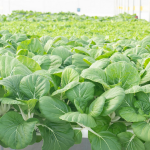The National Agricultural Research and Extension Institute (NAREI) is currently exploring the option of increased usage of bio-stimulants which will help to increase cassava yield.
The use of bio-stimulants is being promoted based on research and tests carried out. These show an increase in the quantity of cassava harvested on the plot of land which is used for regular production. NAREI has already moved towards implementing the use of this chemical.
Research Scientist, with responsibility for the cassava production program, Premdat Beecham told Government Information Agency (GINA) that, “One of the works that we’re doing is the utilization of improved farming technologies, that’s the utilization of irrigation systems, fertilization systems and the use of bio-stimulants for crop production. Based on results obtained, that would be preliminary results would have proven that the use of bio stimulants has increased crop production, more than 45% and this is an encouraging sign especially for farmers.”
NAREI’s program is aimed at multiplying new and improved varieties of the cassava crop for distribution to farmers across the country. The institute is expected to introduce three new varieties of the root crop shortly.
For some time, a number of pilot projects had been executed in various parts of Regions Three and Four in the process of expanding production. It has been recognized that there is a demand for cassava in the form of flour and efforts are being made to produce this type.
Additionally, farmers can benefit locally by supplying chip factories with cassava for chip production in the near future. This will be in keeping with the Ministry of Agriculture’s campaign to ‘Eat what you grow and grow what you eat’. Based on a Food and Agriculture Organisation (FAO) report, the Caribbean region and its people can benefit from improved economics and health status as a result of increased cassava production.

Premdat Beecham – Research Assistant, Cassava Production, National Agricultural Research and Extension Institute, NAREI
“We have quite a lot of products we can get from cassava especially, we had worked with F.A.O in terms of the utilization of the cassava for bread-making, and we did some tests with 20 and 30 percent of the grated cassava in bread and it came out very successful,” Beecham reported.
The Government of Guyana is working with other member states of the Caribbean Community (CARICOM) to diversify their local produce. This would eventually reduce the region’s food import bill which currently stands at over US$4B annually.
Guyana’s farmers can contribute to regional food security by increasing agricultural output with the exploration of cassava production, and the extensive use of bio-stimulants.
A bio-stimulant used for agricultural purposes usually is made of compounds and micro-organisms which can be applied to the soil of plants or the plants themselves to improve its vigor, yield, and quality. Bio-stimulants foster a plant’s growth and development throughout its cycle, from seedling to the stage of maturity.
“I know that the government is focusing a lot on agriculture especially with agriculture development, and what we are trying to do is do a lot more value addition, and that is one of the components of cassava production where we are lacking, and we need to improve on value addition,” the research scientist explained.







